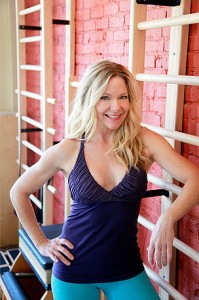May 24, 2017
PERSPECTIVE, PART 2: “DEPTH OF PERCEPTION”
by Amy Havens
In part 1 of this article, I spoke about perspective – our points of view. We each have our own. Some of us share similar opinions but, at the end of the day, we individuate with our points of view through freedom of speech and thought.
When I was a budding Pilates teacher (years ago), I took pride in learning as much as I could about the leaders in the industry. I ordered as many books as I could afford (videos too), printed out articles, etc. – you name it, I did it. I wanted to get my hands on as much as I could to learn, support and honor my choice of profession. Complacent I was not.
Back in those days, to learn new concepts and material, to see and feel the hands-on cueing and teaching, one usually had to travel to conferences and workshops. Was it difficult at times? Yes. Costly? You bet! Convenient? Not always, but I prioritized it because this meant I was applying myself and growing as a Pilates professional. I was watering my garden, if you will. Although I valued my initial education, I wanted more and I knew that if I wanted to matter in this industry someday, I needed to pursue my education deeply and wisely. It might have been easier to “just be a Pilates instructor”, but for me, it was much more than that. It was about education, investment, quality and teaching. I wanted to be an educator that people would trust and look up to one day.
In today’s world of quick and easy information availability, we can discover what we are seeking in a fraction of the time it used to take. But learning isn’t a quick endeavor, especially movement skills, motor learning and repatterning. This is Pilates after all. I feel the younger and newer teachers today are desperate for the information they’re seeking. But are they willing to do the work, the hard, invested work it takes to teach this movement system? It’s difficult sometimes, and it’s not a road that everyone wants to travel. In this accelerated world, why would anyone want to expend more time than needed to get what they’re looking for when they can just hop on and get a quick fix? Social media is handing out visual bites at an alarming rate, and offering insta-learn opportunities for the masses it seems. But I must ask – is this helping or hurting our industry? Social media can be disruptive, a constant comparison and a false perception of what Pilates is.
However, there are still a few deep roots that the “interweb” cannot cut through or pull up, and that is the time spent – in person – with an educator. The Internet has got nothing on this personal experience. It cannot replace the invaluable offering of this unique encounter to hear the teachers voice, to feel their resonance, to watch their hands adjust a body into an ideal alignment or position to make the most out of the exercise, or to see the look in their eye when a student has an “aha” moment — that could change their path of learning for years to come. The personal and physical experience is where it’s at, always. We must feel to learn new movement patterns. It needs to be personal, a felt sense.
As we look at the bigger conversation in the industry, it’s clear the perception is changing also. Instagram and Facebook are not going anywhere and the daily bombardment of crazy, unsafe exercises, video clips of randomness and things being poorly done and represented frighten me.
Perspective:
“a way of regarding, understanding or interpreting something, a mental impression”

Don’t get me wrong, I see some incredible skill and talent on social media; tenacious and courageous educators who have put their time in and are being recognized for it. But just as many imposters are out there also, demonstrating unsafe and illogical movement sequences that do not represent the Pilates that I know or that is.
So, how do I, as a seasoned teacher, accept and acknowledge the new teachers coming into the ring – even though some of their work is not the Pilates I know and learned? How can I/we support them and their endeavors but still hold true to our roots? It’s easy for me, and probably you as well, to answer this: it’s because I’ve/we’ve done the work to know the difference, which takes time. There is no Insta with Pilates; it just doesn’t work that way.
Of greater importance, how does a consumer searching “Pilates” or “Pilates Teacher” on the internet discern the difference? Do they even care? Do they know they should? Do they research anything, or do they just look at the images and make their decisions based upon them? They may, and they do. Just seeing a bendy body doing some crazy exercise doesn’t mean they are a good teacher. But perhaps people aren’t even looking for teachers?
The industry is changing as are our perceptions. People are getting their education in different ways and we are starting to accept this as a new normal. I feel strongly that we need to guide the new teachers and as well as consumers. It’s our responsibility to keep the original spirit of Pilates alive by educating them on what the method was in the beginning (and still is) compared to what they may see today. Only then can they discover what they truly want.
To all the newer teachers out there striving to be seen and recognized, some words of advice from the tree upon which you will someday have a branch – if you so wish:
- Slow down, feel, notice, be here. Plant your seeds with enough space between them for sufficient growth, expansion and survival, water them daily. Take this precious time to nurture your own Pilates practice often, without expectations or strictly for self-promotion. Don’t be in a rush – there is plenty of time and plenty to go around.
- Learn, reflect, question, study, respect this profession please. Pilates has a depth worth waiting for. As Mr. Pilates often said himself, “Rome wasn’t built in a day.” I believe he was referring to the building of the body as well as learning new movement patterns and skills and changing postures. But it can apply here, too. What’s the rush, the push, the urgency? What’s the message you are trying to communicate? How are you being perceived?
- To become a good teacher takes time. You need this time to learn how to teach with efficiency, quality, an eye, an ear, hands, patience and love. Have no expectations and understand that teaching is a huge responsibility, and things change and grow, with time. Teaching requires a dialogue, a conversation. You can’t have a conversation with an image. Pilates is not an image-based system, it’s a movement system.
- Tend to your education as you would to a freshly planted garden. Wait, water it often, observe it, pick the dead weeds, till the soil, cultivate freshness, Roll Back and relish in your depth of perception.

Amy holds a B.A. in Dance from Colorado State University. She was first introduced to the Pilates Method by way of her modern dance teachers and soon met Gary Calderone and Jeff Woodman, both graduates of The Pilates Center of Boulder, CO. Immediately becoming fascinated with the beauty, grace, strength, and logic of this method, she knew becoming a Pilates teacher was in her future. She recognized this was a mental and physical practice and a lifelong discipline. Amy moved to the San Francisco bay area to pursue a performing career and like many dancers, sustained an injury. Pilates and chiropractic were her means of rehabilitation and it was the transition out of the dance world that enabled Amy to follow her intuition to deepen her relationship with the Pilates Method. She completed her Comprehensive Teacher Training Program through The PhysicalMind Institute® taught by Madeline Black and Jean Sullivan and as an apprentice, was asked to teach at A Body of Work in San Francisco. Amy is the owner of CenterPoint Pilates Inc, a premier studio in Santa Barbara, CA. You can see more about Amy here.

